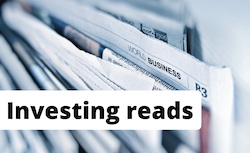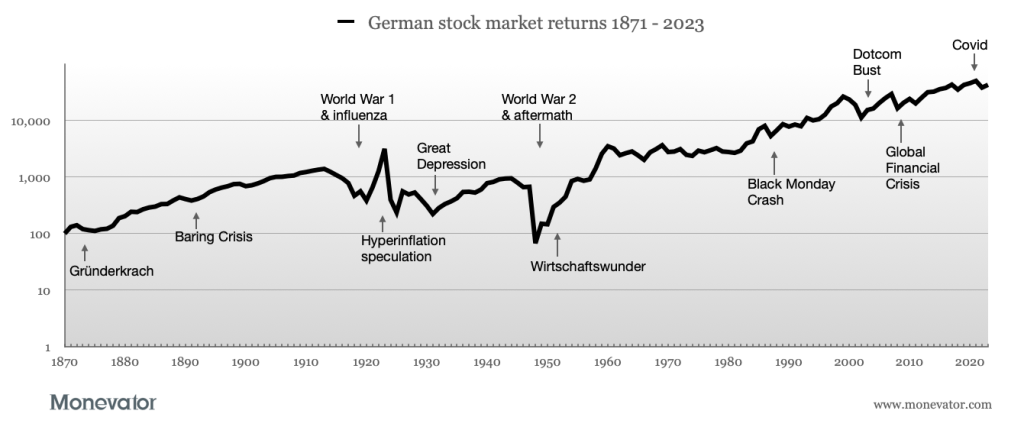
Anybody else feeling more hopeful? Or noticing that – despite self-reporting as a rational human being – their portfolio affects their mood like the wind spins a weathervane?
Last quarter’s surge saw our Slow & Steady model portfolio roar back nearly 7% since our last check-in.
We ended up 9% for the year, all told. The reverses of the last two years have almost been undone (ignoring inflation) and suddenly the January blues don’t seem so bad.
Here’s the numbers in HappyDays-o-vision:
The Slow & Steady portfolio is Monevator’s model passive investing portfolio. It was set up at the start of 2011 with £3,000. An extra £1,264 is invested every quarter into a diversified set of index funds, tilted towards equities. You can read the origin story and find all the previous passive portfolio posts in the Monevator vaults.
Check out in particular the 10% quarterly jump in UK government bonds – hitherto the portfolio villain for the past two years.
That other wealth-filching dog of late, global property, has also made amends with a near-13% rise.
Mind over doesn’t matter
The post-2021 downturn has proven once again that investing is a game played almost entirely in the mind.
It’s been a relatively mild slump. (So far, anyway…)
Yet it’s felt like an awful slog.
Perhaps the (retrospectively) easy wins of 2009-2021 skewed expectations?
Or maybe it’s because the spectacular bond fail of 2022-2023 undid the comforting but simplistic notion that government bonds are ‘safe’?
Or perhaps portfolios aren’t so much ego extensions for many of us but rather fortresses. Built to provide a measure of protection against the slings and arrows of an uncertain world.
It’s scary when your defences crumble.
And almost nothing passive investors held for the last two years worked except commodities – an asset class that had been written-off as a disaster area for more than a decade.
Get rid
When something hurts you, the natural response is to push it as far away as possible.
Buying an asset when it’s on sale is much harder than it sounds. Just consider the number of comments we received last year asking “why should I bother with bonds?”
It’s interesting then to read Vanguard’s upbeat take on battered bonds in its market outlook for 2024:
Despite the potential for near-term volatility, we believe this rise in interest rates is the single best economic and financial development in 20 years for long-term investors.
Our bond return expectations have increased substantially. We now expect UK bonds to return a nominal annualised 4.4%–5.4% over the next decade, compared with the 0.8%–1.8% annualised returns we expected before the rate-hiking cycle began…
If reinvested, the income component of bond returns at this level of rates will eventually more than offset the capital losses experienced over the last two years. By the end of the decade, bond portfolio values are expected to be higher than if rates had not increased in the first place.
Vanguard’s soothsayers believe the near-zero interest rate world has passed into history. A combination of rising government debt and aging demographics will force interest rates to settle onto a permanently higher plane.
We’ll see.
Safety in numbers
For anyone still feeling burned by the bond crash, we’ve previously made the case that buying high and selling low is as bad with bonds as it is for equities.
It’s true too that higher-yielding bonds should eventually self-heal the damage that rate rises inflicted on bond portfolios’ capital values.
Meanwhile, filling the confidence-vacuum created by imploding bonds, we’ve seen trading platforms heavily-promoting safety-first money market funds.
Cash has rarely looked more regal and I dare say that many investors now hold it as their main defensive asset class.
But the following long-term chart shows the potential opportunity cost of that approach:
Cash – as represented by the money market ETF with the longest track record I can find (green column) – failed to deliver even half the cumulative return of an intermediate bond tracker over the past 18 years.
American humble pie
The unrelenting dominance of US equities is the other key takeaway for anyone investing with 20/20 hindsight.
Who needs diversification when you can invest in an S&P 500 tracker and rule the world? Our tilts to UK equities, property, emerging markets, and small caps have all cost us dear.
So why look beyond America?
Well, here’s another forecast. This time we’re showing the 10-year real expected returns estimated by renowned fund shop Research Affiliates:
Research Affiliates places emerging markets, UK equities, and global property well ahead of the global market (All Country) when it comes to likely future returns.
And US large cap equities (not shown) are expected to deliver just a 2% annualised return.
Commodities diversification looks worthwhile if the mooted 3.4% average return is near the mark. As does persevering with index-linked bonds (‘UK ILBs’ in the chart).
Cash (in the shape of UK T-Bills, the pink column) is the only asset class forecast to post negative (nominal) returns while the cyan columns shows Research Affiliate’s nominal bond outlook.
Naturally none of this futurology tells us what will happen for sure. Research Affiliates has been predicting that emerging markets will eclipse US large caps for years, for example.
But it’s a useful reminder that banking everything on the S&P 500 is merely recency bias masquerading as an investment strategy.
Annual rebalancing time
Okay, there’s just time for some light annual portfolio maintenance.
We previously committed to an asset allocation shift of 2% per year from conventional gilts to index-linked bonds until we are 50-50 split between them.
That means this quarter:
The Vanguard UK Government Bond index fund decreases to a 25% target allocation
The Royal London Short Duration Global Index Linked (GBP hedged) fund increases to a 15% target allocation
Note though that our overall allocation to equities and bonds remains static at 60/40.
We also annually rebalance our positions back to their preset asset allocations at this point in every year.
After 2023, that mostly means selling off a few per cent of our Developed World ex-UK fund, and putting the proceeds into index-linked bonds.
Inflation adjustments
Next we increase our contribution by RPI every year to maintain our purchasing power.
This year’s inflation figure is 5.3%, so we’ll invest £1,264 per quarter in 2024.
That’s an increase from just £750 back in 2011. Inflation adds up.
New transactions
Our stake is split between seven funds according to our predetermined asset allocation. The trades play out as follows:
UK equity
Vanguard FTSE UK All-Share Index Trust – OCF 0.06%
Fund identifier: GB00B3X7QG63
New purchase: £114.99
Buy 0.455 units @ £252.71
Target allocation: 5%
Developed world ex-UK equities
Vanguard FTSE Developed World ex-UK Equity Index Fund – OCF 0.14%
Fund identifier: GB00B59G4Q73
Rebalancing sale: £1572.32
Sell 2.667 units @ £589.50
Target allocation: 37%
Global small cap equities
Vanguard Global Small-Cap Index Fund – OCF 0.29%
Fund identifier: IE00B3X1NT05
New purchase: £60.22
Buy 0.148 units @ £407.35
Target allocation: 5%
Emerging market equities
iShares Emerging Markets Equity Index Fund D – OCF 0.21%
Fund identifier: GB00B84DY642
New purchase: £510.22
Buy 279.665 units @ £1.82
Target allocation: 8%
Global property
iShares Environment & Low Carbon Tilt Real Estate Index Fund – OCF 0.17%
Fund identifier: GB00B5BFJG71
New purchase: £229.13
Buy 98.94 units @ £2.32
Target allocation: 5%
UK gilts
Vanguard UK Government Bond Index – OCF 0.12%
Fund identifier: IE00B1S75374
Rebalancing sale: £162.77
Sell 1.189 units @ £136.89
Target allocation: 25%
Royal London Short Duration Global Index-Linked Fund – OCF 0.27%
Fund identifier: GB00BD050F05
New purchase: £2084.55
Buy 1970.271 units @ £1.06
Dividends reinvested: £201.46 (Buy another 190.42 units)
Target allocation: 15%
New investment contribution = £1,264
Trading cost = £0
Take a look at our broker comparison table for your best investment account options. InvestEngine is currently cheapest if you’re happy to invest only in ETFs. Or learn more about choosing the cheapest stocks and shares ISA for your circumstances.
Average portfolio OCF = 0.16%
If this all seems too complicated check out our best multi-asset fund picks. These include all-in-one diversified portfolios, such as the Vanguard LifeStrategy funds.
Interested in tracking your own portfolio or using the Slow & Steady investment tracking spreadsheet? Our piece on portfolio tracking shows you how.
Finally, learn more about why we think most people are better off choosing passive vs active investing.
Take it steady,
The Accumulator
The post The Slow and Steady passive portfolio update: Q4 2023 appeared first on Monevator.



